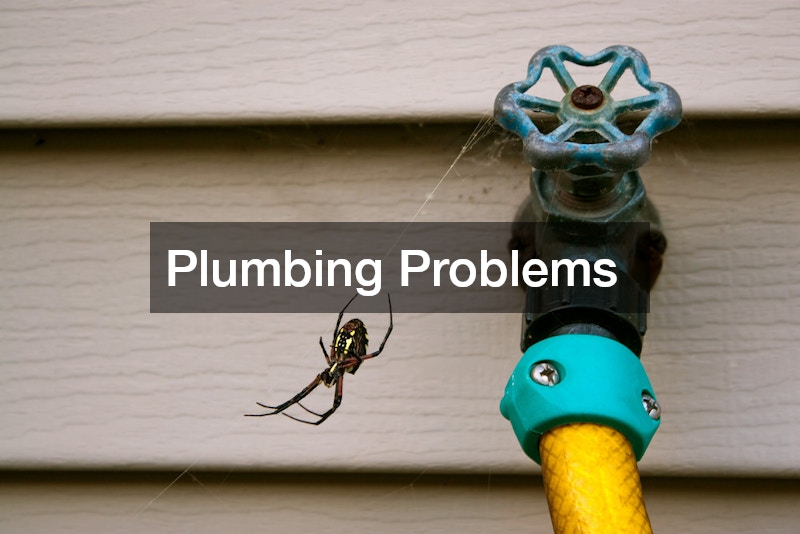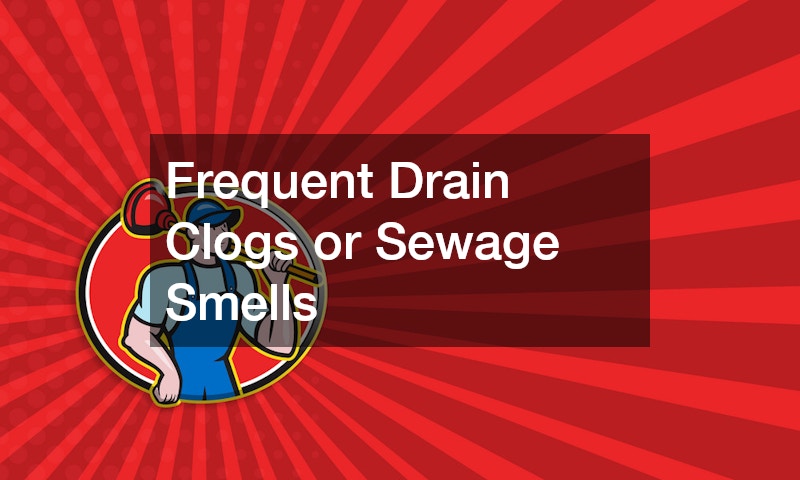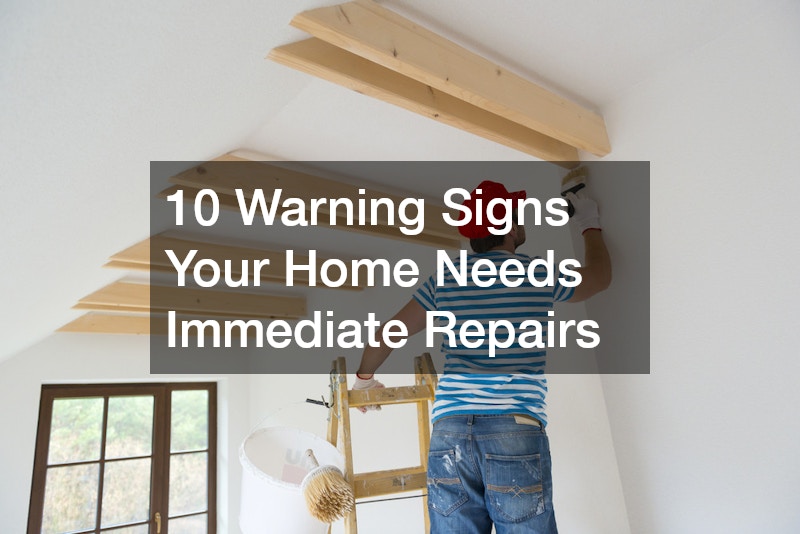Your home is your most significant investment, and keeping it in excellent condition requires regular maintenance and timely repairs. Ignoring small warning signs can lead to more extensive and expensive problems, compromising your home’s safety, comfort, and value. Recognizing these signs early ensures you can take swift action to prevent further damage.
From leaking rain gutters to HVAC malfunctions, every part of your home requires attention to function efficiently. Issues like roof damage, clogged drains, or faulty plumbing can disrupt your daily life and cause long-term structural problems. Whether it’s scheduling roof repairs, plumbing repair, or furnace repair, knowing when to act can save you from costly replacements or emergencies.
This article highlights ten critical warning signs that your home needs immediate repairs, including visible damage to siding, frequent clogs indicating the need for septic system repairs, and rising energy bills that might call for an AC replacement. Understanding these signals and acting promptly ensures your home remains safe, energy-efficient, and comfortable.
By learning to spot these issues and addressing them with the help of professionals like gutter services, siding services, or licensed plumbers, you’ll safeguard your home’s longevity and protect your investment. Let’s dive into the key warning signs every homeowner should watch for.
1. Persistent Roof Leaks or Damage

2. Overflowing or Damaged Rain Gutters
Your rain gutters play a critical role in directing water away from your home, protecting your roof, foundation, and siding. However, when gutters become clogged, sagging, or damaged, they can no longer function effectively, leading to costly issues like water intrusion, foundation cracks, and mold growth.
Signs of Gutter Problems
- Overflowing water during rainstorms.
- Sagging or detached sections of gutters.
- Visible cracks, rust, or leaks in the gutter system.
How to Address the Issue
- Clean Regularly: Remove debris like leaves and twigs to keep water flowing freely.
- Inspect for Damage: Check for loose brackets, cracks, or gaps in the seams, and repair them promptly.
- Schedule Professional Services: Hire experts for thorough maintenance or repairs if your rain gutters show extensive wear.
Preventative Measures
- Install gutter guards to reduce debris buildup.
- Perform seasonal inspections, particularly in fall and spring, to catch problems early.
Ignoring damaged or clogged rain gutters can result in severe water damage to your home. Regular cleaning, repairs, and timely replacements ensure they function effectively, protecting your property and prolonging the life of your roof and foundation. Proper maintenance is a small investment compared to the potential cost of extensive water damage.
3. Plumbing Problems

Plumbing issues can disrupt your daily routine and lead to significant water damage if not addressed promptly. From minor leaks to more serious concerns, understanding when to tackle a repair yourself and when to call professional plumbers can save you time and money.
Common Signs of Plumbing Issues
- Leaky Faucets or Pipes: Persistent dripping or visible water pooling.
- Low Water Pressure: Often caused by clogged pipes or hidden leaks.
- Unusual Noises: Banging or gurgling sounds from pipes could signal blockages or air pockets.
- Slow Drains: Recurring clogs may indicate a deeper issue in the plumbing system.
Steps to Address Problems
- DIY Solutions: Use a plunger or drain snake for minor clogs and replace worn washers in leaky faucets.
- Schedule Professional Plumbing Repair: For persistent leaks, major clogs, or pipe damage, call licensed plumbers to assess and fix the problem.
Preventative Maintenance
- Regularly inspect pipes, fixtures, and drains for signs of wear.
- Avoid pouring grease or heavy debris down the drains to prevent clogs.
Timely plumbing repair not only prevents water damage but also ensures your home’s plumbing system operates efficiently. Whether it’s a minor fix or a major overhaul, professional plumbers are your best resource for keeping your home’s water systems in top condition.
4. Rising Energy Bills
A sudden spike in your energy bills can signal inefficiencies in your home’s systems. Common culprits include an aging HVAC unit, leaky windows, or outdated appliances. Ignoring these issues can lead to higher costs and unnecessary energy waste.
Signs of Inefficient Systems
- Your air conditioner runs constantly but struggles to cool your home.
- Unusual noises or weak airflow from vents.
- Heating systems that fail to maintain consistent temperatures.
Steps to Address the Problem
- Schedule a professional inspection of your HVAC system to identify inefficiencies.
- Consider an AC replacement if your unit is over 10-15 years old or requires frequent repairs. Modern systems are more energy-efficient and can significantly lower utility costs.
Investing in an AC replacement not only reduces energy bills but also improves comfort and reduces your carbon footprint. Addressing inefficiencies promptly ensures a more cost-effective and sustainable home.
5. Frequent Drain Clogs or Sewage Smells

Recurring drain clogs or sewage odors in your home are more than just inconvenient—they could indicate serious plumbing issues. If left unaddressed, these problems can lead to significant damage or costly repairs.
Common Causes
- Grease, hair, or debris buildup in pipes leading to frequent clogs.
- A failing septic system causing backups or unpleasant odors.
Steps to Address the Problem
- For minor clogs, use a plunger or drain snake to clear blockages.
- Persistent issues or foul odors may indicate the need for septic system repairs. A malfunctioning septic system can cause backups and even contaminate groundwater.
Preventative Measures
- Avoid flushing non-biodegradable items down the toilet.
- Schedule regular inspections and pumping of your septic system to prevent major failures.
Frequent clogs and sewage smells are warning signs that shouldn’t be ignored. Timely septic system repairs and maintenance ensure your plumbing system functions efficiently and your home remains safe and odor-free.
6. Damaged Siding
Your home’s siding serves as a protective barrier against the elements while enhancing curb appeal. Damaged siding, such as cracks, warping, or peeling, compromises this protection and can lead to moisture intrusion, mold growth, and pest infestations. Addressing these issues quickly is essential to maintain your home’s structural integrity.
Signs of Siding Damage
- Cracks or holes in the siding.
- Warped or buckling panels.
- Faded or peeling paint, which may indicate moisture problems.
Steps to Address the Issue
- For minor damage, repair small cracks with sealant or patching materials.
- Significant damage often requires professional siding services to replace panels or install new siding entirely.
Preventative Measures
- Clean your siding regularly to remove dirt and mildew.
- Inspect for damage after storms and address issues promptly.
Partnering with expert siding services ensures your home remains protected and visually appealing, preventing small issues from turning into costly repairs.
7. Worn or Leaning Fences
Fences provide privacy, security, and curb appeal, but over time, they can become worn or start leaning due to weather, age, or soil shifts. Ignoring these issues can lead to further damage, making repairs more extensive and expensive.
Signs of Fence Damage
- Cracked, broken, or rotting boards.
- Leaning posts or sagging sections.
- Rusted hardware or loose connections.
Steps to Address the Issue
- Replace broken boards and panels with new ones of the same material.
- Reinforce leaning posts by resetting them with concrete for stability.
- Tighten or replace rusted screws and hinges to restore functionality.
Preventative Measures
- Regularly stain or paint wooden fences to protect them from weather damage.
- Inspect the fence annually and address minor issues early to avoid costly repairs.
Timely fence maintenance keeps your property secure and visually appealing. If the damage is extensive, consulting a professional for a full repair or replacement ensures durability and long-term results.
8. HVAC Malfunctions
Your HVAC system is essential for maintaining a comfortable and energy-efficient home. However, malfunctions can lead to uneven temperatures, reduced air quality, and higher energy bills if not addressed promptly.
Signs of HVAC Issues
- Inconsistent heating or cooling throughout your home.
- Unusual noises like rattling, banging, or hissing.
- Poor airflow or foul odors coming from vents.
- An unexplained spike in energy bills.
Steps to Address HVAC Problems
- Check and replace dirty air filters to improve airflow and efficiency.
- Inspect the thermostat for proper settings and functionality.
- Schedule professional maintenance to clean coils, ducts, and other components.
When to Seek Professional Help
If your system continues to underperform, a certified HVAC technician can diagnose and fix complex issues, including motor or compressor failures.
Preventative Measures
- Perform routine maintenance, including seasonal checkups, to prevent breakdowns.
- Invest in an energy-efficient HVAC system to reduce operating costs over time.
Addressing HVAC malfunctions early ensures consistent comfort, improved efficiency, and a longer system lifespan.
9. Furnace Issues in Colder Months
A functioning furnace is vital for keeping your home warm during colder months. When your furnace starts showing signs of trouble, prompt action is essential to ensure comfort and avoid costly breakdowns.
Signs Your Furnace Needs Attention
- Insufficient heating or uneven temperatures in your home.
- Loud noises such as banging, rattling, or squealing from the unit.
- Frequent cycling on and off or a failure to turn on.
Steps to Address Furnace Problems
- Replace dirty filters to improve airflow and efficiency.
- Check the thermostat settings to ensure proper operation.
- Schedule professional furnace repair to address issues like a malfunctioning blower motor, igniter, or heat exchanger.
Preventative Measures
- Have your furnace inspected and serviced annually by a qualified technician.
- Address minor problems early to prevent costly repairs or a complete breakdown.
Timely furnace repair ensures your home stays warm and energy-efficient throughout the winter while extending the lifespan of your heating system.
10. Outdoor and Septic System Problems
Issues with your outdoor septic system can lead to serious problems if not addressed promptly. From backups to unpleasant odors, these signs often indicate underlying damage that requires immediate attention.
Signs of Septic System Problems
- Pooling water or soggy ground near the septic tank or drain field.
- Foul odors around your yard or inside your home.
- Slow drains or frequent clogs throughout the house.
Steps to Address Septic Issues
- Limit water usage and avoid flushing non-biodegradable items to prevent further strain on the system.
- Schedule professional septic system repairs to address blockages, leaks, or mechanical failures in the tank.
Preventative Measures
- Have your septic system inspected and pumped every 3-5 years to maintain efficiency.
- Ensure the drain field is free of heavy equipment or overgrown vegetation to prevent damage.
Timely septic system repairs protect your property, maintain sanitation, and prevent costly system failures.
Conclusion: Act Quickly to Protect Your Home
Identifying and addressing warning signs like leaks, clogs, HVAC issues, and septic system problems is essential to maintaining a safe, functional, and comfortable home. Prompt action on issues such as roof repairs, plumbing repair, or furnace repair prevents small problems from escalating into costly damage. Regular maintenance, like cleaning rain gutters or inspecting your HVAC system, ensures long-term efficiency and peace of mind. For complex repairs, always consult professionals for services like siding services or septic system repairs to protect your investment. Proactive care keeps your home in great condition and ensures a safe environment for years to come.

